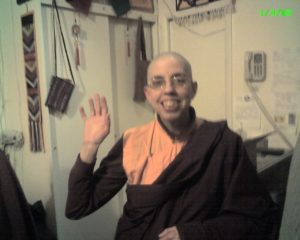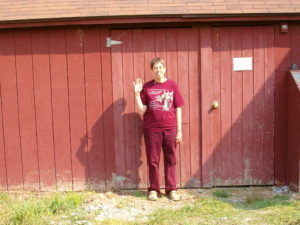A number of good books exist that can help you get started meditating. We have studied several of them at Kagyu Samten Chöling in New Hampshire. Bokar Rinpoche’s Meditation: Advice for Beginners is our standard handbook. I recently read Mingyur Rinpoche’s Joy of Living and found his instructions extremely helpful as well. (The first part is about the correspondences between traditional Buddhist methodology and recent discoveries about how the brain works. It’s quite interesting, but you can go directly to part two for the meditation instructions.)
It’s best to supplement your study of a book with direct instruction from a qualified teacher, especially if you are interested in a particular spiritual tradition. As a reminder, or in case you don’t have any other resources handy, here’s a concise introduction to the basic procedure of what our tradition calls calm abiding meditation, the first type we do, which helps to calm our mind and train it to stay focused rather than zoom off after every thought that pops up.
Sit down. (You can also do walking meditation, but I’m not addressing that here.) Pick a place where you’re not likely to be interrupted, and a realistic time frame (five or ten minutes is good to start), and resolve that you will absolutely, definitely not get up from your seat during that time for any reason short of a certifiable emergency. If you accomplish this much, even if you don’t feel you did anything else, that is the first triumph of meditation: you have already gained a bit of control over your unruly mind.
Pay attention to posture, but don’t get fraught about it. There are traditional instructions on posture that you can get from a teacher or a book, and following them can help your mind settle down more easily. But according to Mingyur Rinpoche, the posture can be summed up in two points: keep your spine comfortably straight (including the neck) and the rest of your body as relaxed as possible. I am not able to sit cross-legged on a floor cushion, which is the traditional posture considered most conducive to settling the mind; so I sit in a chair, but I can still observe these two points (and most of the others).
Pick something to rest part of your attention on. It can be a visual object, or whatever sounds arise while you are sitting, or, probably the most popular and easy to use: your breathing. Just breathe normally, don’t try to manipulate your breathing in any way; it should be relaxed and natural, and your only job is to observe it. Whatever your focus, the goal is to keep track of it during the entire time you are sitting. However, it should only take up a small part of your awareness, just enough that you always know it is there; the rest of your mind is relaxed and wide open to whatever sensory input arises from without or within. During this time, keep your mind alert to notice each thought that appears; then: don’t engage your mind with that thought, just notice that it has come up—and let it go. (Do NOT kick it out; just let it make its own way to wherever it is going next.) This is not easy, and we may be able to do it only for very short periods—even a second at a time—but each time we let a single thought or emotion pass without getting caught up in it—even if we only manage it once per session, even if we spend the rest of the time completely caught up in one thought after another—that is the next triumph of meditation. If you meditate regularly, it will get easier and easier; and you may even notice that you are sometimes able to apply this skill just when you need it in everyday life—if even once you avoid a confrontation or stressful situation by letting a potential provocation pass, that is the next triumph of meditation!
Give up any idea that you are doing it wrong. This seems to be a pitfall peculiar to us Westerners, who think a) everything is complicated, and b) we should do it perfectly the first time we try it. As long as you are making a sincere effort to apply this very simple method according to your understanding of it, you are meditating, and you will definitely gain benefit from your practice. Or, as Mingyur Rinpoche puts it, the “intention to meditate” is what really counts. There are refinements you can learn from further study, but all you really need is to sit and do it. Don’t think about how it’s going—if you’re thinking, you’re not meditating; conversely, if you’re letting go of thoughts about whether it’s going well or not: you’re meditating!
Do it every day. If every day is not possible, do it as regularly as you can. “Every time you feel like it” won’t get you anywhere fast. It’s best to make a plan and stick to it. The benefits may not be apparent right away, so don’t give up at the end of a week when nirvana doesn’t seem to be in sight. Lama Norlha Rinpoche assures his students that if we keep at it, practicing regularly and attentively, we will start to notice an improvement in our mental and emotional well-being within a few weeks or months.
P.S. About walking meditation: There are a lot of ways to do walking meditation, but the simplest is to apply this technique (except for sitting part) while you are taking a walk. It’s very portable, and can make walks more spacious, relaxing, and vivid. But: don’t neglect sitting meditation; regular practice on your cushion or chair in a quiet, undisturbed place is the key to steady progress.


